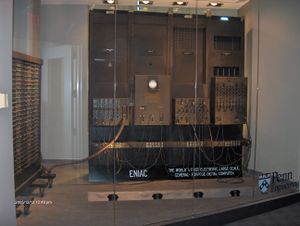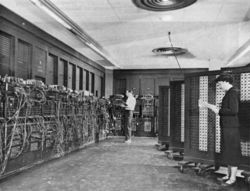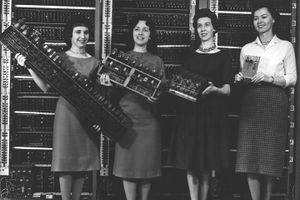إنياك
 أربع ألواح نياك وأحد جداوله الوظيفية الثلاثة، معروضة في كلية الهندسة والعلوم التطبيقية بجامعة پنسلڤانيا. | |
موقع إنياك في فيلادلفيا. | |
| Location | قسم علوم الحاسوب والمعلومات في جامعة پنسلڤانيا، 3330 والنت ستريت، فيلادلفيا، الولايات المتحدة |
|---|---|
| Coordinates | 39°57′08″N 75°11′28″W / 39.9522012°N 75.1909932°WCoordinates: 39°57′08″N 75°11′28″W / 39.9522012°N 75.1909932°W |
| PA marker dedicated | الخميس، 15 يونيو، 2000 |

إنياك ENIAC ( /ˈini.æk/ أو /ˈɛni.æk/؛ اختصار التكامل الرقمي الإلكتروني والحاسوب Electronic Numerical Integrator and Computer)[1][2] كان من أوائل الحواسب الإلكترونية عامة الغرض. كان حاسوب تام-تورينگ، رقمي وقادر على حل "فئة كبيرة من المشاكل الرقمية".[3][4]
على الرغم من من أنه تم تصميمه ليستخدم بصفة أساسية في حساب جداول إطلاق المدفعية لمعمل الأبحاث البالستية التابع للجيش الأمريكي،[5][6] إلا أن أول برامجه تضمنت دراسة جدوى القنبلة الهيدروجينية.[7]
في 15 فبراير 1946 تم تخصيص إنياك رسمياً لجامعة پنسلڤانيا، وكان متوقعاً له من قبل الصحافة أن يكون "العقل الضخم".[8] كانت سرعته في تنفيذ الأمر أعلى ألف مرة عن الآلات الكهروميكانيكية؛ هذه القوة الحاسوبية، المقترنة بقابلية البرمجة عامة الأغراض، أثارت حماسة العلماء ورجال الصناعة على حد سواء. الجمع بين السرعة وقابلية البرمجة سمح بإنجاز آلاف العمليات الحسابية لحل المشكلات، حيث أن إنياك قادر على حساب مسار يستغرق من البشر 20 ساعة لإنجازه، في 30 ثانية (2400× زيادة في السرعة).[9]
. . . . . . . . . . . . . . . . . . . . . . . . . . . . . . . . . . . . . . . . . . . . . . . . . . . . . . . . . . . . . . . . . . . . . . . . . . . . . . . . . . . . . . . . . . . . . . . . . . . . . . . . . . . . . . . . . . . . . . . . . . . . . . . . . . . . . . . . . . . . . . . . . . . . . . . . . . . . . . . . . . . . . . . .
البرمجة
انظر أيضاً
- قائمة الحاسوبة
- تاريخ عتاد الحاسوب
- History of computing hardware
- List of vacuum tube computers
- حواسب عسكرية
- مؤسسة أونيسيس
- Kathleen Antonelli (Kay McNulty)
- أرثر بركس
- بتي هولبرتن
- مارلين ملتزر
- جين جنينگز بارتيك
- فرانسيس بيلاس سپنس
- Ruth Lichterman Teitelbaum
الهوامش
- ^ Eckert Jr., John Presper and Mauchly, John W.; Electronic Numerical Integrator and Computer, United States Patent Office, US Patent 3,120,606, filed 1947-06-26, issued 1964-02-04; invalidated 1973-10-19 after court ruling on Honeywell v. Sperry Rand.
- ^ Weik, Martin H. "The ENIAC Story". O R D N A N C E. 708 Mills Building - Washington, DC: American Ordnance Association (January–February 1961). Archived from the original on 2011-08-14. Retrieved 2015-03-29.
{{cite journal}}: Unknown parameter|dead-url=ignored (|url-status=suggested) (help)CS1 maint: location (link) - ^ Goldstine & Goldstine 1946, p. 97
- ^ Shurkin, Joel (1996). Engines of the mind: the evolution of the computer from mainframes to microprocessors. New York: Norton. ISBN 0-393-31471-5.
- ^ Moye, William T. (January 1996). "ENIAC: The Army-Sponsored Revolution". US Army Research Laboratory. Archived from the original on 2017-09-15. Retrieved 2015-03-29.
{{cite web}}: Unknown parameter|dead-url=ignored (|url-status=suggested) (help) - ^ Goldstine 1972
- ^ Scott McCartney p.103 (1999): "ENIAC correctly showed that Teller's scheme would not work, but the results led Teller and Ulam to come up with another design together."
- ^ Brain used in the press as a metaphor became common during the war years. Looking, for example, at Life magazine: 1937-08-16, p.45 Overseas Air Lines Rely on Magic Brain (RCA Radiocompass). 1942-03-09 p.55 the Magic Brain—is a development of RCA engineers (RCA Victrola). 1942-12-14 p.8 Blanket with a Brain does the rest! (GE Automatic Blanket). 1943-11-08 p.8 Mechanical brain sights gun (How to boss a BOFORS!)
- ^ "ENIAC". ENIAC USA 1946. History of Computing Project. 2013-03-13. Retrieved 2016-05-18.
المصادر
- "Electronic Computing Circuits of the ENIAC", Proceedings of the I.R.E. 35 (8): 756–767, 1947, doi:
- "The ENIAC: The First General-Purpose Electronic Computer", Annals of the History of Computing 3 (4): 310–389, 1981, doi:
- Copeland, B. Jack, ed. (2006), Colossus: The Secrets of Bletchley Park's Codebreaking Computers, Oxford: Oxford University Press, ISBN 978-0-19-284055-4
- Eckert, J. Presper, The ENIAC (in Nicholas Metropolis, J. Howlett, Gian-Carlo Rota, (editors), A History of Computing in the Twentieth Century, Academic Press, New York, 1980, pp. 525–540)
- Eckert, J. Presper and John Mauchly, 1946, Outline of plans for development of electronic computers, 6 pages. (The founding document in the electronic computer industry.)
- Fritz, W. Barkley, The Women of ENIAC (in IEEE Annals of the History of Computing, Vol. 18, 1996, pp. 13–28)
- "The Electronic Numerical Integrator and Computer (ENIAC)", Mathematical Tables and Other Aids to Computation 2 (15): 97–110, July 1946, doi:, ISSN 0891-6837 (also reprinted in The Origins of Digital Computers: Selected Papers, Springer-Verlag, New York, 1982, pp. 359–373)
- Goldstine, Herman H. (1972). The Computer: from Pascal to von Neumann. Princeton, New Jersey: Princeton University Press. ISBN 0-691-02367-0.
{{cite book}}: Invalid|ref=harv(help) - Mauchly, John, The ENIAC (in Metropolis, Nicholas, Howlett, Jack; Rota, Gian-Carlo. 1980, A History of Computing in the Twentieth Century, Academic Press, New York, ISBN 0-12-491650-3, pp. 541–550, "Original versions of these papers were presented at the International Research Conference on the History of Computing, held at the Los Alamos Scientific Laboratory, 10–15 June 1976.")
- Rojas, Raúl; Hashagen, Ulf, editors. The First Computers: History and Architectures, 2000, MIT Press, ISBN 0-262-18197-5
- McCartney, Scott (1999). ENIAC: The Triumphs and Tragedies of the World's First Computer. Walker & Co. ISBN 0-8027-1348-3.
قراءات إضافية
- Berkeley, Edmund. GIANT BRAINS or machines that think. John Wiley & Sons, inc., 1949. Chapter 7 Speed – 5000 Additions a Second: Moore School's ENIAC (Electronic Numerical Integrator And Computer)
- Dyson, George (2012). Turing's Cathedral: The Origins of the Digital Universe. New York City: Pantheon Books. ISBN 978-0-375-42277-5.
- Hally, Mike. Electronic Brains: Stories from the Dawn of the Computer Age, Joseph Henry Press, 2005. ISBN 0-309-09630-8
- Lukoff, Herman (1979). From Dits to Bits: A personal history of the electronic computer. Portland, Oregon, USA: Robotics Press. ISBN 0-89661-002-0. LCCN 79-90567.
- Tompkins, C. B.; Wakelin, J. H.; High-Speed Computing Devices, McGraw-Hill, 1950.
- Stern, Nancy (1981). From ENIAC to UNIVAC: An Appraisal of the Eckert-Mauchly Computers. Digital Press. ISBN 0-932376-14-2.
- McCartney, Scott (1999). ENIAC: The Triumphs and Tragedies of the World's First Computer. Walker & Co. ISBN 0-8027-1348-3.
وصلات خارجية
- ENIAC simulation
- Another ENIAC simulation
- Yet another ENIAC simulator
- Q&A: A lost interview with ENIAC co-inventor J. Presper Eckert
- Interview with Eckert Transcript of a video interview with Eckert by David Allison for the National Museum of American History, Smithsonian Institution on February 2, 1988. An in-depth, technical discussion on ENIAC, including the thought process behind the design.
- Oral history interview with J. Presper Eckert, Charles Babbage Institute, University of Minnesota. Eckert, a co-inventor of ENIAC, discusses its development at the University of Pennsylvania's Moore School of Electrical Engineering; describes difficulties in securing patent rights for ENIAC and the problems posed by the circulation of John von Neumann's 1945 First Draft of the Report on EDVAC, which placed the ENIAC inventions in the public domain. Interview by Nancy Stern, 28 October 1977.
- Oral history interview with Carl Chambers, Charles Babbage Institute, University of Minnesota. Chambers discusses the initiation and progress of the ENIAC project at the University of Pennsylvania Moore School of Electrical Engineering (1941–46). Oral history interview by Nancy B. Stern, 30 November 1977.
- Oral history interview with Irven A. Travis, Charles Babbage Institute, University of Minnesota. Travis describes the ENIAC project at the University of Pennsylvania (1941–46), the technical and leadership abilities of chief engineer Eckert, the working relations between John Mauchly and Eckert, the disputes over patent rights, and their resignation from the university. Oral history interview by Nancy B. Stern, 21 October 1977.
- Oral history interview with S. Reid Warren, Charles Babbage Institute, University of Minnesota. Warren served as supervisor of the EDVAC project; central to his discussion are J. Presper Eckert and John Mauchly and their disagreements with administrators over patent rights; discusses John von Neumann's 1945 draft report on the EDVAC, and its lack of proper acknowledgment of all the EDVAC contributors.
- ENIAC Programmers Project
- The women of ENIAC
- Programming ENIAC
- How ENIAC took a Square Root
- Mike Muuss: Collected ENIAC documents
- ENIAC chapter in Karl Kempf, Electronic Computers Within The Ordnance Corps, November 1961
- The ENIAC Story, Martin H. Weik, Ordnance Ballistic Research Laboratories, 1961
- ENIAC museum at the University of Pennsylvania
- ENIAC specifications from Ballistic Research Laboratories Report No. 971 December 1955, (A Survey of Domestic Electronic Digital Computing Systems)
- A Computer Is Born, Michael Kanellos, 60th anniversary news story, CNet, February 13, 2006
- Gumbrecht, Jamie (8 February 2011). "Rediscovering WWII's 'computers'". CNN.com. Retrieved 9 February 2011.
- CS1 errors: unsupported parameter
- CS1 maint: location
- Pennsylvania state historical marker significations
- Coordinates on Wikidata
- حاسبات عقد 1940
- حاسبات مبكرة
- حاسبات عسكرية
- One-of-a-kind computers
- Vacuum tube computers
- أطروحات 1946 متعلقة بالحواسب
- مكونات المدفعية
- تشغيل المدفعية
- إلكترونيات عسكرية أمريكية
- جامعة پنسلڤانيا
- تاريخ الهندسة الإلكترونية
- حواسب عشرية

